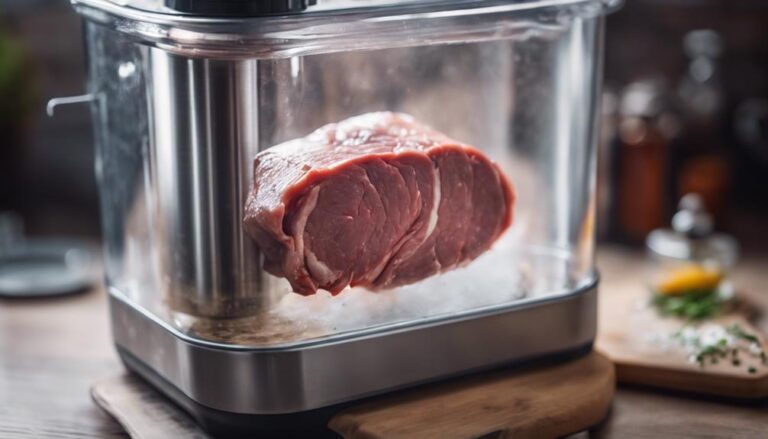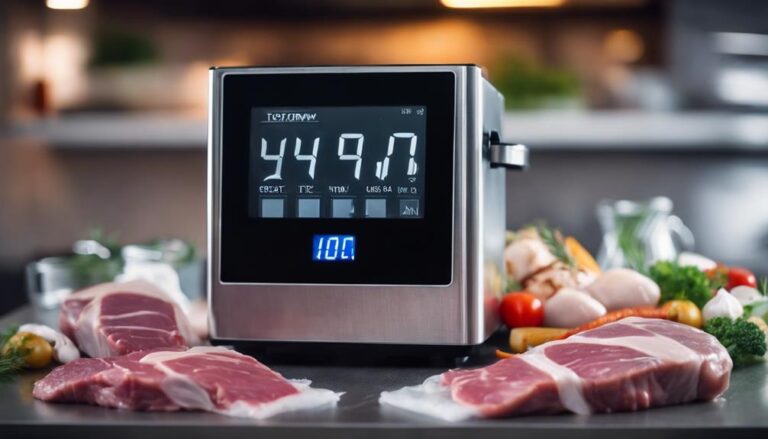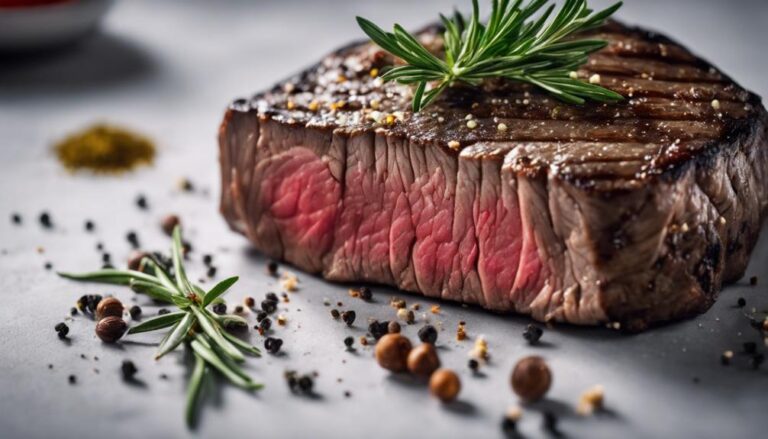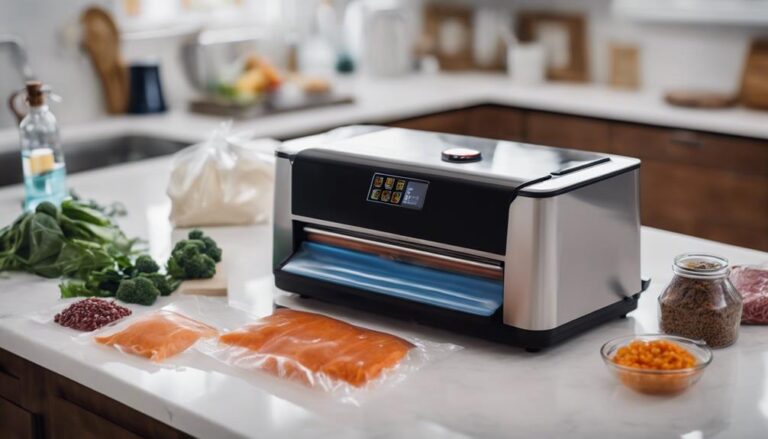Effortless Tips for Successful Sous Vide Cooking
Master precise temperature control for perfect doneness. Keep water level up, use a lid, and monitor levels. Seal food tightly and time based on thickness. Searing adds flavor – caramelize for yum. Want to elevate your sous vide game?
What You Will Learn Here
- Master precise temperature control for ideal doneness.
- Properly seal food to maintain cooking conditions.
- Follow timing guidelines based on thickness for perfect results.
- Use searing to enhance flavor and texture.
- Monitor water level and position sous vide machine correctly.
Temperature Control for Sous Vide
To excel in sous vide cooking, master the art of precise temperature control. Sous vide cooking relies on maintaining a consistent temperature to guarantee both food safety and achieving ideal doneness. By carefully controlling the temperature of the water bath, you can customize the cooking process to deliver consistent and flavorful results every time.
With sous vide, different foods require specific temperature ranges to reach their perfect texture and taste. Whether you're cooking a tender steak or delicate fish, precise temperature control is crucial to maximizing the full potential of your ingredients. By maintaining a constant temperature throughout the cooking duration, you guarantee that your food cooks evenly and retains its natural juices and flavors.
Water Bath Preparation
For optimal water bath preparation in sous vide cooking, make sure that the water level in your container stays above the minimum line to avoid overheating. To guarantee a successful sous vide cooking experience, consider the following tips:
- Use a Lid: Prevent water evaporation during long cooking sessions for consistent temperature.
- Monitor Water Level: Check periodically to maintain cooking precision and avoid fluctuations.
- Position Machine Carefully: Keep the sous vide machine away from edges to prevent spills or water damage.
- Utilize a Sous Vide Rack: Organize multiple bags for even water circulation around the food.
- Stay Organized: Keep everything in order to streamline the cooking process and enhance efficiency.
Proper Food Sealing Techniques
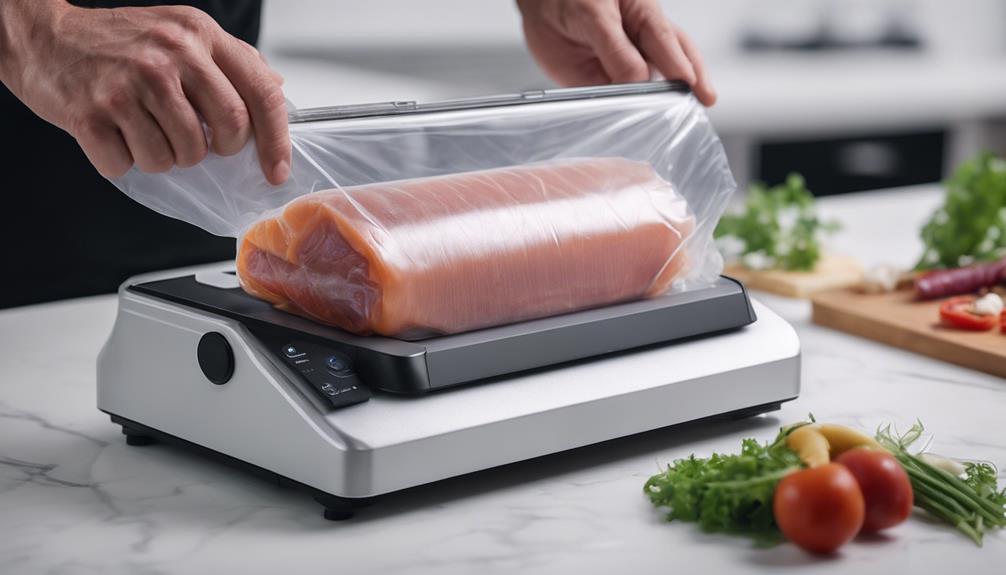
Make sure your food is tightly sealed to maintain ideal cooking conditions in sous vide preparation. Properly sealed bags are essential in sous vide cooking to prevent water from entering and compromising the food.
Using a vacuum sealer is a great way to remove air and create a tight seal around the ingredients, guaranteeing efficient cooking. If you don't have a vacuum sealer, Ziploc bags can also be used effectively by utilizing the displacement method to remove air pockets and seal the bag securely.
When preparing your ingredients, seal the bag properly before submerging it in the water bath. This step helps to maintain consistent heat distribution and ensures excellent cooking results.
Sous Vide Timing Guidelines
When mastering sous vide cooking, understanding the appropriate timing guidelines is crucial for achieving perfect results with your dishes. Proper timing guarantees that your sous vide foods are cooked precisely to your liking.
Here are some key points to keep in mind regarding sous vide cook time:
- Thicker cuts of meat require longer cooking times to reach temperature equilibrium in sous vide cooking.
- Timing ranges for steaks typically fall between 1 to 4 hours depending on desired doneness.
- Texture of the food is influenced by the precise temperature and cooking duration in sous vide preparation.
- The thickness, not the weight of the food, is the key factor in determining the appropriate cooking time.
- Achieving the desired texture and doneness level is dependent on the accurate timing and temperature control in sous vide cooking.
Importance of Searing
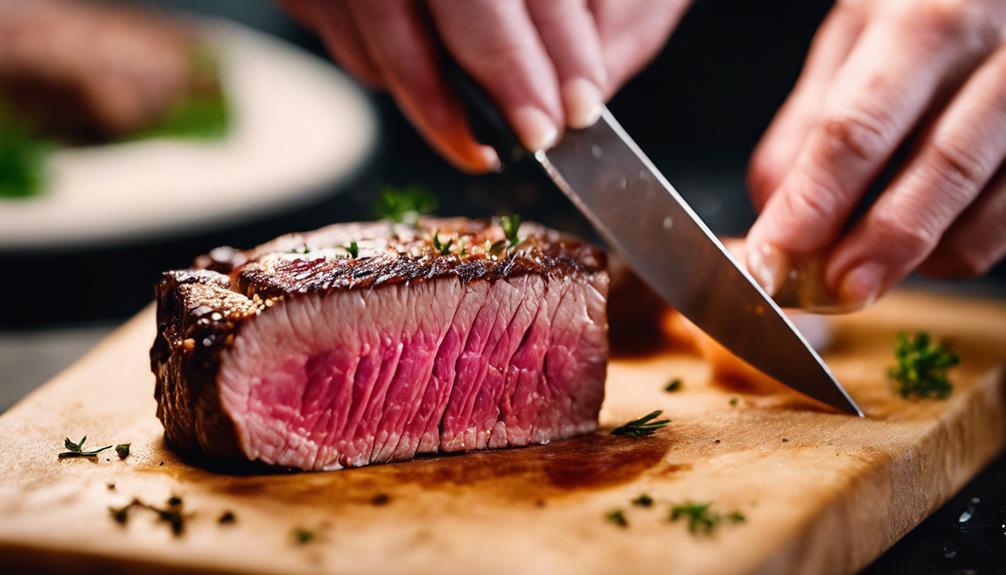
Enhancing the flavor and texture of your sous vide dishes, searing plays an essential role in achieving restaurant-quality results. After cooking your proteins using the sous vide method, searing them in a hot pan or grill not only adds a deliciously flavorful crust but also enhances the appearance and texture of the final dish. The high heat used during searing helps caramelize the surface of the proteins, creating an extra layer of depth of flavor that elevates your meal to a whole new level.
To achieve a proper sear, make sure the surfaces of your proteins are dry before placing them in a hot pan. This dryness allows for better browning and guarantees a more flavorful outcome. Remember, searing isn't just an optional step; it's a critical final touch in the sous vide cooking process that's necessary for achieving that desired restaurant-quality finish. So, next time you cook sous vide, don't skip the searing step – it's the key to a successful sous vide dish.
Experimenting With Different Dishes
After achieving a perfect sear on your proteins, the next step is to broaden your sous vide horizons by experimenting with different dishes. Sous vide cooking allows you to explore a wide range of options beyond just meats. Here are some ideas to get you started:
- Try different proteins such as beef, chicken, pork, and fish to understand how each type cooks sous vide.
- Experiment with vegetables like asparagus, carrots, and broccoli to discover the best texture and flavor profiles sous vide provides.
- Immerse into desserts such as creme brulee, cheesecake, and poached fruits to experience how sous vide can elevate sweet treats.
- Test out side dishes like potatoes, corn, and green beans to see how sous vide enhances the natural flavors of vegetables.
- Explore unique dishes like octopus, duck confit, and short ribs to push the boundaries of sous vide cooking and create gourmet meals.
Each dish presents a new opportunity to showcase the precision and flavor infusion that sous vide cooking offers.
Exploring Sous Vide Recipes
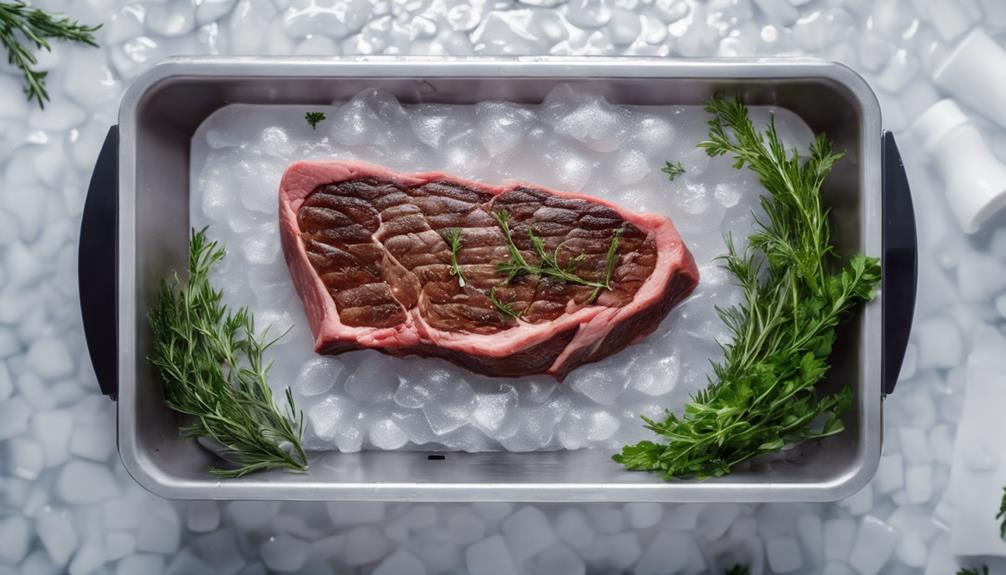
To explore your sous vide cooking skills, immerse yourself in a variety of recipes that showcase the versatility and precision of this cooking method. Sous vide recipes offer a wide array of options, from entrees and desserts to side dishes and meats. With the help of an immersion circulator, you can achieve perfectly cooked dishes with precise temperature control.
Popular sous vide recipes like halibut with honey-roasted beets, chicken tikka masala, ginger creme brulee, and pork chops with mojo sauce highlight the delicious outcomes possible through this method. Experiment with new flavors and textures by trying recipes such as salmon with apple, asparagus with vinaigrette, sweet potatoes, and chicken thighs with orange mint glaze.
Cooking sous vide guarantees consistent results, whether you're preparing ribeye with Asian glaze or corned beef Reuben sandwiches. Embrace the opportunity to elevate your culinary skills and treat your guests to exceptional dishes using the magic of sous vide cooking.
Frequently Asked Questions
What Is the Secret of Sous Vide?
The secret of sous vide lies in precise temperature control and vacuum sealing. Sous vide techniques guarantee flavor infusion, tender results, and juicy meats through slow, precision cooking. Understanding cooking times and moisture retention leads to delicious outcomes effortlessly.
What Is the First Thing I Should Sous Vide?
For your first sous vide adventure, start with a protein like steak for perfection. Achieve chicken tenderness, seafood succulence, or veggie delights later. Master steak first; it's a delicious and rewarding way to begin your sous vide journey.
How Do Professional Chefs Use Sous Vide?
To achieve restaurant-quality results, professional chefs use sous vide for precise temperature control, flavor infusion, and texture perfection. It saves time, allows for ingredient experimentation, and offers consistent, versatile dishes. Culinary creativity shines with sous vide's precision cooking.
What Is a Disadvantage of Sous Vide?
When considering sous vide, a drawback lies in the longer cooking times required, affecting time-sensitive meals. Additionally, precise temperature control can be challenging for beginners. Texture, flavor, and browning may differ from traditional methods, influencing overall satisfaction.
Conclusion
Now that you've learned these effortless tips for successful sous vide cooking, you're ready to take your culinary skills to the next level.
With precise temperature control, proper sealing techniques, and timing guidelines, you'll be creating delicious dishes with ease.
Don't forget the importance of searing for that perfect finish, and feel free to experiment with different recipes to truly master the art of sous vide cooking.
Happy cooking!

